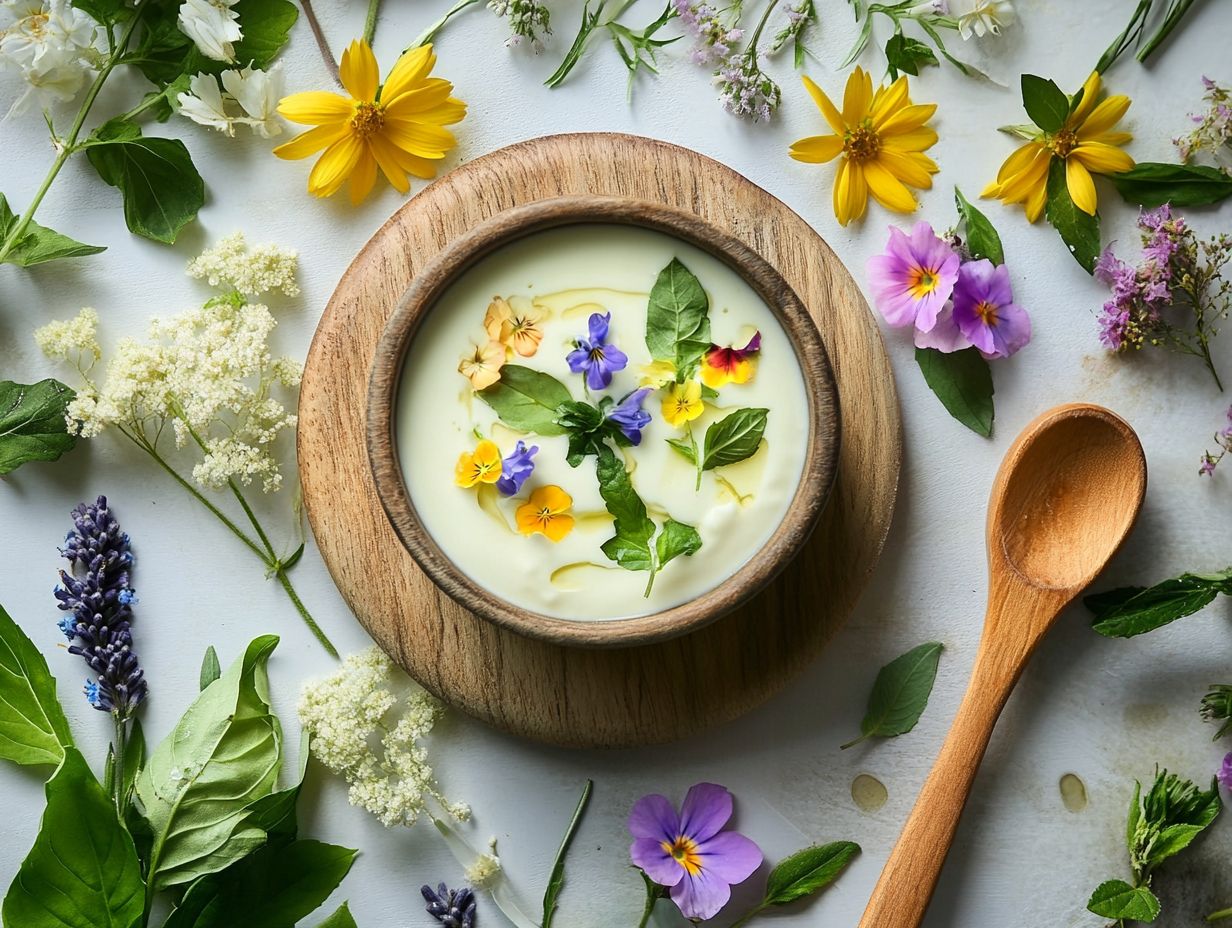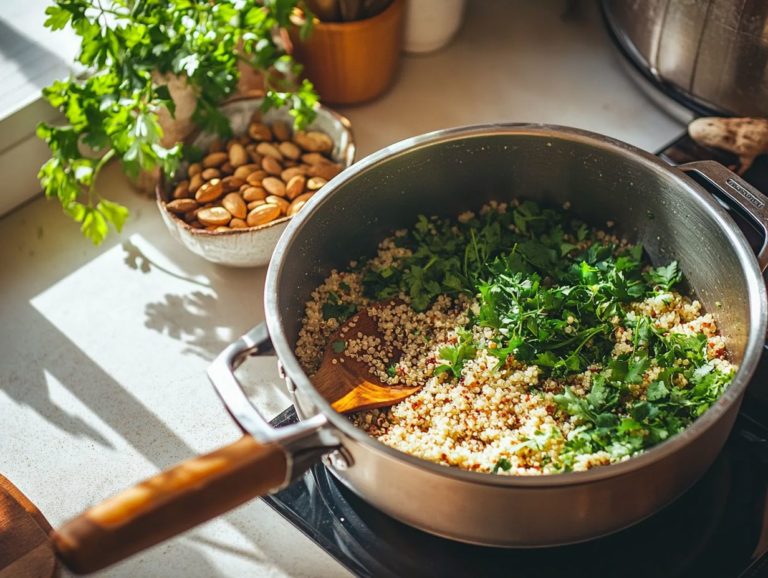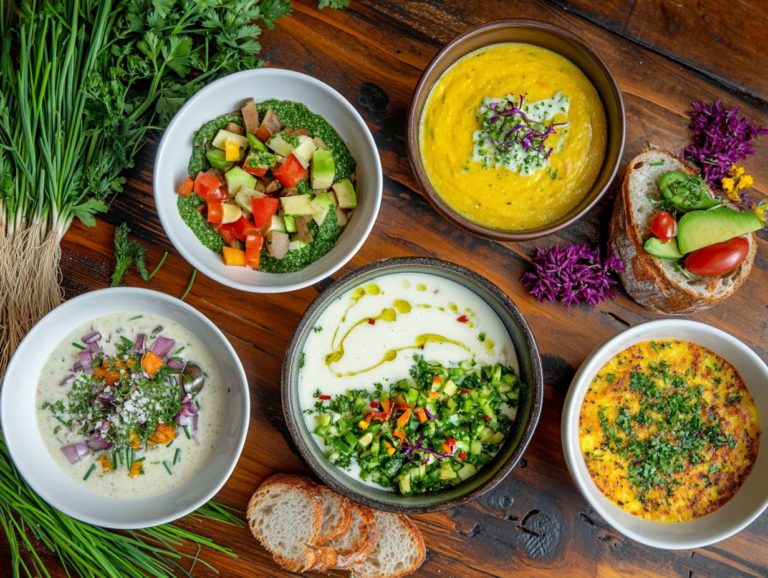How to Incorporate Wild Edibles into Sauces
Have you ever tasted the unique flavors of nature? Wild edibles are like nature’s secret gems, packed with distinctive flavors and remarkable nutritional benefits.
This article delves into the art of enhancing your culinary creations by seamlessly incorporating foraged ingredients into sauces.
You’ll gain insights into their nutritional value and safe harvesting practices, along with mastering the techniques necessary for their integration.
Additionally, you’ll uncover inventive recipes that highlight these wild treasures. Immerse yourself in this journey and discover how to elevate your dishes with the vibrant essence of the wild!
Contents
- Key Takeaways:
- Benefits of Incorporating Wild Edibles into Sauces
- Identifying and Harvesting Wild Edibles
- Incorporating Wild Edibles into Sauces
- Recipes and Ideas for Using Wild Edibles in Sauces
- Frequently Asked Questions
- Can I use any type of wild edible in sauces?
- How do I properly clean wild edibles before incorporating them into sauces?
- What are some popular types of sauces that incorporate wild edibles and other seasonal ingredients?
- Can I substitute wild edibles for traditional herbs in sauces?
- Do I need to cook wild edibles before adding them to sauces?
- Are there any safety precautions I should take when using wild edibles in sauces?
Key Takeaways:

- Incorporating wild edibles into sauces not only adds flavor and nutrition but also promotes sustainable foraging practices.
- Knowing how to safely identify and harvest wild edibles is crucial for using them in sauces.
- There are many ways to incorporate wild edibles into sauces from using them as a base to adding them as a garnish; the possibilities are endless!
Discovering Wild Edibles
Wild edibles present an intriguing realm of plant life, showcasing a variety of healthy ingredients like dandelion greens, nettles, wild garlic, and chanterelles, all of which have enriched culinary endeavors for centuries.
These distinctive plants not only delight your taste buds but also play an essential role in fostering biodiversity and enhancing ecosystem health.
With a diverse selection of wild edibles from sweet berries to robust roots you are invited to explore an array of flavors and textures while embracing the locavore movement, which is the idea of eating locally sourced food.
Many of these plants have cultural significance, often intertwined with traditions passed down through generations, illuminating the profound relationship between people and their environment.
Join community foraging activities to discover local plants and meet new friends!
Benefits of Incorporating Wild Edibles into Sauces
Incorporating wild edibles into your sauces brings a wealth of benefits, from boosting nutritional value to creating unique flavor profiles that elevate any culinary masterpiece.
By using plants such as dandelion greens and wild garlic, you not only enhance the depth of your sauces but also support sustainable harvesting practices.
This approach encourages you to explore the vibrant flavors of seasonal ingredients, forging a connection with local ecosystems and crafting dishes that celebrate the rich essence of wild food culture.
Nutritional Value and Flavor Enhancement
Wild edibles offer remarkable nutritional benefits, often outshining conventional vegetables in terms of vitamins, minerals, and antioxidants.
Incorporating these treasures into your diet can elevate your meals beyond the ordinary. These nutrient-dense ingredients not only keep you healthy but also introduce unique flavors that can invigorate your culinary creations, from salads to sauces.
By embracing herbs like wild garlic and nutrient-rich greens such as nettles, you can craft dishes that honor the culture of wild foods while emphasizing health and wellness.
Consider dandelion greens, frequently underestimated, which are bursting with vitamins A, C, and K. They bring a delightful bitterness to salads that pairs exquisitely with sweeter dressings.
Then there’s purslane, a powerhouse of omega-3 fatty acids, which adds a succulent texture that beautifully complements savory dishes.
By weaving these wild edibles into your menu, you can experiment with vibrant combinations, transforming simple pasta sauces or hearty stews into adventurous culinary experiences that celebrate the true flavors of nature while keeping you healthy.
Start foraging today and transform your meals with the wonders of the wild!
Identifying and Harvesting Wild Edibles

Identifying and harvesting wild edibles is an art that requires a keen understanding of the diverse array of plants that are safe for consumption. This journey begins with mastering plant identification and familiarizing yourself with local foraging regulations.
Practicing safe foraging is crucial; you want to steer clear of toxic plants, which are plants that look similar but can be harmful if consumed, while ensuring your methods align with sustainable ecological principles. Participating in community foraging activities not only enriches your knowledge of edible treasures like morels and wild watercress but also fosters a deeper respect for the environment and encourages the responsible enjoyment of nature’s bounty.
Safe and Sustainable Foraging Practices
Safe and sustainable foraging practices are essential for you to relish the richness of nature while safeguarding local ecosystems and complying with legal regulations.
You’ll want to cultivate a sharp eye for identifying plants, as many edible species have toxic look-alikes that could jeopardize your health. Joining local foraging clubs or attending expert-led workshops can offer you invaluable, hands-on experience in distinguishing edible varieties, all while learning about the crucial timing of harvests for optimal quality and safety.
It s vital to grasp the ecological impact of foraging. As a responsible forager, you should only take what you need and leave enough behind to ensure natural regeneration. This respect for the environment nurtures a sustainable relationship with nature, allowing future generations to also experience the joys and health benefits that foraging brings.
Incorporating Wild Edibles into Sauces
Transform ordinary dishes into extraordinary ones by incorporating wild edibles into your sauces! This can elevate your culinary creations and celebrate nature’s vibrant flavors. For tips on how to use edible plants in your cooking, turning your kitchen into a delightful playground for culinary exploration.
Techniques like crafting wild green pesto or blending seasonal greens into zesty salsas allow you to showcase the unique tastes of foraged ingredients. This approach invites you to experiment with diverse cooking methods that highlight natural flavors while honoring the environment.
Embracing this practice not only enriches your culinary journey but also cultivates a profound appreciation for the wild food culture.
Methods and Techniques
When you delve into the world of wild edibles in sauces, you unlock a treasure trove of methods and techniques that can elevate both the flavors and nutritional value of your dishes, allowing for an exciting culinary journey. Techniques like sautéing, blending, or even drying herbs are excellent ways to maximize the potential of wild ingredients such as wild garlic and dandelion greens. For those looking to explore further, learning how to make wild edible risotto can be a delightful addition to your culinary repertoire.
By preserving these wild edibles through pickling or creating herb-infused oils, you can enjoy their unique flavors year-round while embracing sustainable cooking practices.
Steaming and blanching help maintain the vibrant colors and textures of these ingredients, enhancing their natural flavors and appealing to both the palate and the eye. Incorporating wild edibles into your culinary repertoire opens the door to an exhilarating flavor profile that emphasizes their earthy and sometimes floral notes.
It s all about experimenting; for instance, tossing saut ed greens into pasta or using dried herbs to craft seasoning blends can transform even the most basic meals into something extraordinary.
By embracing the seasonal bounty of wild edibles, you can not only delight in their distinctive tastes but also champion sustainable cooking practices that align with nature s rhythms.
Recipes and Ideas for Using Wild Edibles in Sauces

Exploring the realm of wild food recipes unveils a treasure trove of opportunities for integrating wild edibles into innovative and exquisite sauce preparations. For those looking to enhance their culinary creations, learning how to substitute wild edibles in recipes can give a refreshing twist to classic dishes.
Imagine incorporating nettles into a creamy sauce or crafting a vibrant salsa verde infused with wild garlic each possibility is a canvas for culinary creativity.
Every recipe beckons you to experiment with flavor combinations, guaranteeing that no meal becomes routine, while elegantly showcasing the splendor of cooking with nature s bounty.
Creative and Delicious Ways to Use Wild Edibles
There are countless creative and delicious ways to incorporate wild edibles into your cooking, blending their unique flavors and health benefits into your everyday meals. Imagine crafting gourmet sauces using herbs like wild garlic or preparing rustic dishes that celebrate seasonal greens. For more inspiration, learn how to use foraged ingredients in cooking. Embracing wild food recipes can elevate your culinary skills and offer a wonderful opportunity to connect with local food communities through searching for edible plants in nature. Each dish can reflect your personal taste while showcasing the diverse flavor profiles these wild ingredients provide.
These intriguing ingredients often come with rich stories and traditions that enhance your dining experience. Brighten up your salads with colorful wildflowers for a delightful twist, or incorporate foraged mushrooms to add earthy depth to risottos creamy Italian rice dishes and soups. Experimenting with fruits like wild berries can lead to delightful jams or refreshing beverages.
By reaching out to local foraging communities, you not only expand your knowledge of these wild foods but also cultivate a sense of belonging and shared passion for sustainable cooking practices.
Frequently Asked Questions
Can I use any type of wild edible in sauces?
Yes, you can use a variety of wild edibles such as dandelion greens, ramps, wild garlic, and more in sauces.
How do I properly clean wild edibles before incorporating them into sauces?

It is important to thoroughly wash and inspect any wild edibles before using them in sauces to remove any dirt or debris.
What are some popular types of sauces that incorporate wild edibles and other seasonal ingredients?
Wild edible pesto, wild garlic aioli, and dandelion greens sauce are just a few examples of sauces that use wild edibles.
Can I substitute wild edibles for traditional herbs in sauces?
Yes, you can also substitute wild edibles for traditional herbs in sauces to add a unique flavor and nutritional boost.
Do I need to cook wild edibles before adding them to sauces?
It is recommended to lightly cook or blanch wild edibles before adding them to sauces to enhance their flavor and reduce any bitterness.
Are there any safety precautions I should take when using wild edibles in sauces?
Yes, it is important to properly identify wild edibles and ensure they are from a safe and clean source before incorporating them into sauces.
Get started on your wild foraging adventure today!






